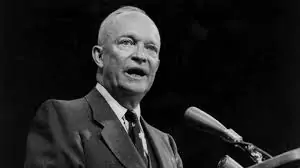The Birth of the Uniparty
It’s older than you think.

|
Getting your Trinity Audio player ready...
|
The uniparty, featuring Republicans who dutifully implement the left’s agenda, only promising to do it a bit more slowly, cheaply, or efficiently, was not born with Mitt Romney or John McCain or Paul Ryan. It actually dates to 1952.
Republicans in 1952 not only won the presidency for the first time since 1928; they also won control of both houses of Congress for the first time since 1946 (the Eightieth Congress that Harry Truman had so relentlessly and successfully assailed during the 1948 campaign). Many Republicans wanted to roll back some of the Roosevelt-era programs that had expanded federal government control over so many areas of American life.
The incoming president, Dwight D. Eisenhower, however, would not hear of this. He asserted: “Should any party attempt to abolish social security and eliminate labor laws and farm programs, you would not hear of that party again in our political history. There is a tiny splinter group, of course, that believes you can do these things…. Their number is negligible and they are stupid.” This is a level of elitism and contempt for the common people that rivals that of Kevin McCarthy and Mitch McConnell.
The Eisenhower administration backed up these harsh words with actions that would have pleased the architect of New Deal socialism, Franklin Delano Roosevelt. It expanded the social security program and supported a bill raising the hourly minimum wage from seventy-five cents ($9 today) to a dollar ($12 today). It tried, but failed, to get a bill passed requiring the federal government to underwrite private health insurance policies, which was the beginning of the long push for government control over the health care system.
The Eisenhower administration was generally a period of great prosperity. However, in the year after Eisenhower implemented his minimum wage increase, unemployment jumped from 4.2 percent to 5.2 percent, and the economy went into a recession. This was entirely predictable: faced with larger operating expenses, many business owners will cut costs by laying off workers. When the government mandates those larger operating expenses, unemployment will rise, and the economy will suffer.
With the Republicans implementing large government programs, and the Democrats remaining the standard-bearers for an expanded federal government, voters had no choice but to accept it. Even Eisenhower realized this. In 1964, three years out of office and a popular and respected elder statesman, he wrote an article for the Saturday Evening Post entitled “Why I Am a Republican.” In it, he declared: “I am increasingly disturbed by the steady, obvious drift of our nation toward a centralization of power of the Federal Government. And in this fact is found the primary reason why I sincerely urge all voters, no matter their present political affiliations, to take a fresh, thoughtful look at the basic Republican philosophy and Republican performance as compared to that of the Democrats. For the hard fact is that under many years of Democratic Party leadership our country has been lured into the ‘easy way,’ a path of federal expediency which, like a narcotic, may give us a false sense of well-being, but in the long run is dangerous to our future, our basic rights, our moral fiber and our individual freedom.”
This was no doubt true. But as president, Eisenhower had done little to halt the expansion of federal power. He resisted numerous measures that would have repealed or rolled back New Deal programs. He was determinedly bipartisan, going along with numerous Democratic initiatives, even when they involved the centralization that he warned against. In 1954, he stated his guiding philosophy: “I have just one purpose, outside of the job of keeping this world in peace…and that is to build up a strong progressive Republican Party in this country. If the right wing wants a fight, they are going to get it. If they want to leave the Republican Party and form a third party, that’s their business, but before I end up, either this Republican Party will reflect progressivism or I won’t be with them anymore.”
That meant that both parties endorsed a rapidly expanding federal government, higher taxes, and more state interference in the daily lives of Americans. His 1964 article suggests that, by then, he had seen the error of his ways. But by then, it was too late. Eisenhower’s “Modern Republicanism” reduced the Republican Party to a faint echo of the Democrats. Democrats would formulate grand proposals that generally involved a massive expansion of government spending and control, and instead of challenging these proposals at their foundations and arguing against them on principle, Republicans would merely quibble that they could be implemented more cheaply and efficiently. Eisenhower ensured that even when Republicans were in the majority, they continued to have a minority mentality: the Democrats were setting the agenda for the country.
There would be pushback against this assumption within the Republican Party, but the dominant mainstream of Republicanism ever since Ike has been to say “Me too” to the Democrats, rather than “I object.” Eisenhower didn’t originate the idea of making the Republican Party a pale copy of the Democratic Party, rather than a genuine principled opposition: FDR’s foes in 1936, 1940, and 1944, Alf Landon, Wendell Willkie, and Thomas E. Dewey would likely have done much the same thing, but they lost and he won, so Eisenhower must be credited as the primary architect of what is essentially a single party in two factions that has, for the most part, governed America since the 1950s.
Until Donald Trump, that is.

